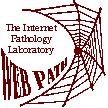Bacterial Infections
How do bacteria cause disease? Here are some examples:
Growth in tissues destroys the tissues from release of proteolytic enzymes Release of exotoxins
Vibrio cholerae - severe watery diarrhea Corynebacterium diptheria - growth promotes elaboration of a myocardial
toxin [Identification] Staphylococcus aureus - acute self-limited diarrhea [Identification]
Release of endotoxins
gram negative bacteria such as E. coli and Klebsiella are most prone to do this, because the lipopolysaccharide (LPS) in the cell wall is a potent endotoxin. attract neutrophils, cause fever, can produce shock
Antigens are similar to host antigens, generating immune reaction:
Group A Streptococcus producing post-streptococcal glomerulonephritis and
rheumatic heart disease
Appearances
Microscopic: primary cellular response is neutrophils (chemotactic
factors include C5a, leukotrienes, HPETE) which is non-specific and destructive
Gross: redness, swelling, purulent exudate (pustule, abscess), necrosis
Clinical: fever (interleukin), pain (bradykinin, prostaglandin),
increased WBC count
Algorithms for Laboratory Diagnosis
Sites of infection and organisms involved
Skin infection
Staphylococcus aureus - impetigo [Identification] Streptococcus group A - often due to hemolysins, toxins, and streptolysins elaborated by the bacteria. Lancefield typing of these organisms (based on cell wall polysaccharide, or lipoteichoic acid moiety, antigens) can be performed for epidemiologic purposes [Identification] Vibrio vulnificans - necrotizing skin infection with sepsis
Respiratory tract Gastrointestinal tract
Salmonella typhi - typhoid fever with longitudinal ulcers of small
intestine (inflammation with lymphocytes, plasma cells, and macrophages), neutropenia, and splenomegaly [Identification] Vibrio [Identification]
Vibrio cholerae - florid diarrhea from non-invasive organisms producing
enterotoxin that activates adenylate cyclase Vibrio parahemolyticus - infection is associated with seafood consumption, particularly in Florida. It occasionally causes septicemia Vibrio vulnificus - can cause septicemia and death following ingestion of seafood or from contamination of wounds in a marine environment. V. vulnificus is the leading cause of death in the US related to seafood consumption, particularly raw Gulf Coast oysters
enteropathogenic E. coli - "traveler's diarrhea" - enterotoxin
produces diarrhea similar to, but not as severe as, cholera; can be life-threatening in infants and children Shigella - bacillary dysentery from superficially invasive bacteria with
ulceration of colon [Identification] Helicobacter pylori - gastritis Clostridium difficile - pseudomembranous colitis from enterotoxin when
normal gut flora diminished by antibiotic therapy [Identification] Bacteroides fragilis - intra-abdominal sepsis [Identification] Food poisoning in the buffet line
Staphylococcus aureus - enterotoxin - vomiting and diarrhea hours after ingestion [Food] Salmonella - diarrhea and cramps 1 to 2 days after ingestion of bacteria [Identification] [Food] Clostridium botulinum - botulism with paralysis from neurotoxin in poorly
prepared food Bacillus cereus - vomiting within hours of ingesting foods in which the spores germinate and grow readily, such as reheated fried rice [Identification] [Food]
Urinary tract Genital/congenital
Neisseria gonorrheae - gonorrheal infection [Identification] Streptococcus - group B strep with stillbirth and neonatal infection [Identification] Listeria monocytogenes - chorioamnionitis with abortion, stillbirth, or
neonatal sepsis with meningitis [Identification]
Heart (endocardium): infection arrives from bloodstream and settles on
valve, producing a vegetation; aided by presence of an anatomically abnormal
valve or a large inoculum (intravenous drug use) Meninges: infection arrives from bloodstream, from sinuses, or via direct
trauma
E. coli - neonatal [Identification] Streptococcus group B - neonatal [Identification] Hemophilus influenzae - in children [Identification] Neisseria meningitidis - starts inocuously in nasopharynx, can lead to
disseminated intravascular coagulopathy (DIC) and adrenal hemorrhage and
necrosis (Waterhouse-Friedrichson syndrome) [Identification] Streptococcus pneumoniae - in older persons [Identification]
 Next section. Next section.
 Return to the tutorial menu. Return to the tutorial menu.
|
 Return to the tutorial menu.
Return to the tutorial menu.
 Return to the tutorial menu.
Return to the tutorial menu.